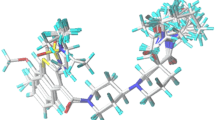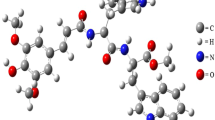Abstract
A detailed investigation is performed for a series of 24 aminosulfonyl carbamates as acyl-CoA: cholesterol O-acyltransferase (ACAT) inhibitors. The biological activity of aminosulfonyl carbamates in terms of log (IC50) has been estimated by developing suitable quantum chemical descriptors in the light of density functional theory. In order to understand inhibitor-biosystem interactions and to identify potential descriptors, a model biosystem is considered which comprises five different nucleic acid bases. Accordingly, two global descriptors, viz. electron affinity (EA) and energy transfer during the interaction between inhibitors and biosystems (∆E), and a local descriptor, viz. group atomic charges on sulfonyl moiety (∑QSul), are developed toward understanding bio-activity of aminosulfonyl carbamates. It is noteworthy to achieve that the three-parameter regression model for considered parameters EA, ∆E, and ∑QSul is observed to predict about 90% activities of aminosulfonyl carbamates in terms of log(IC50). The developed regression model is also statistically validated and successfully tested for unknown compounds.




Similar content being viewed by others
References
Hansch C, Leo A, Taft RW (1991) A survey of Hammett substituent constants and resonance and field parameters. Chem Rev 91:165–195
Gao H, Katzenellenbogen JA, Garg R, Hansch C (1999) Comparative QSAR analysis of estrogen receptor ligands. Chem Rev 99:723–744
Franke R (1984) Theoretical Drug Design Methods. Elsevier, Amsterdam, p 115
Karelson M, Lobanov VS, Katritzky AR (1996) Quantum-chemical descriptors in QSAR/QSPR studies. Chem Rev 96:1027–1044
Cronin MT (2000) Computational methods for the prediction of drug toxicity. Curr Opin Drug Discov Devel 3:292–297
Pearlman RS, Yalkowsky SH, Sikula AA, Valvani SC (eds) (1980) Physical chemical properties of drugs, vol 10. Marcel Dekker, New York
Kubinyi H (1995) In: Wolff ME (ed) Burger’s Medicinal Chemistry. Vol. I5th edn. Wiley-Interscience, New York
Estrada E, Molina E (2001) Novel local (fragment-based) topological molecular descriptors for QSPR/QSAR and molecular design. J Mol Graph Model 20:54–64
Kier LB, Hall LH (1976) Molecular connectivity in chemistry and drug research. Academic Press, New York
Cartier A, Rivail JL (1987) Electronic descriptors in quantitative structure-activity relationships. Chemom Intell Lab Syst 1:335–347
Chattaraj PK, Roy DR (2007) Update 1 of: Electrophilicity index. Chem Rev 107:PR46–PR74
Chattaraj PK, Roy DR (2005) Local descriptors around a transition state: a link between chemical bonding and reactivity. J Phys Chem A 109:3771–3772
Chattaraj PK, Roy DR (2006) Possible union of chemical bonding, reactivity and kinetics. J Phys Chem A 110:11401–11403
Chattaraj PK, Maiti B, Sarkar U (2003) Philicity: a unified treatment of chemical reactivity and selectivity. J Phys Chem A 107:4973–4975
Roy DR, Sarkar U, Chattaraj PK, Padmanabhan J, Parthasarathi R, Subramanian V (2006) Analyzing toxicity through electrophilicity. Mol Divers 10:119–131
Mondal Roy S, Roy DR, Sahoo SK (2015) Toxicity prediction of PHDDs and phenols in the light of nucleic acid bases and DNA base pair interaction. J Mol Graph Model 62:128–137
Sharma BK, Roy DR (2018) Toxicity of polyhalogenated dibenzo-p-furans in the light of nucleic acid bases interaction. Comp Biol Chem 76:225–231
Kanehisa M, Goto S (2000) KEGG: Kyoto encyclopedia of genes and genome. Nucleic Acids Res 28:27–30
Chang TY, Chang CC, Lin S, Yu C, Li BL, Miyazaki A (2001) Acyl-coenzyme:cholesterol acyltransferase-1 an −2. Curr Opin Lipidol 23:289–296
Chang TY, Chang CC, Cheng D (1997) Acyl-coenzyme:cholesterol acyltransferase. Annu Rev Biochem 66:613–638
Small D (1988) Progression and regression of atherosclerotic lesions: insights from lipid physical biochmeistry. Arteriosclerosis 8:103–129
Brown MS, Goldstein JL (1983) Lipoprotein metabolism in the macrophage: implications for cholesterol deposition in atherosclerosis. Annu Rev Biochem 52:223–261
O’Brien PM, Sliskovic DR, Blankley J, Roth BD, Wilson MH, Hamelehle KL, Krause BR, Stanfield RJ (1994) Inhibitors of acyl-CoA:cholesterol O-acyl transferase (ACAT) as hypocholesterolemic agents. 8. Incorporation of amide or amine functionalities into a series of disubstituted ureas and carbamates. Effects on ACAT inhibition in vitro and efficacy in vivo. J Med Chem 37:1810–1822
Augelli-Szafran CE, Blankley CJ, Roth BD, Trivedi BK, Bousley RF, Essenberg AD, Hamelehle KL, Krause BR, Stanfield RL (1993) Inhibitors of acyl-CoA: cholesterol acyltransferase. 5. Identification and structure-activity relationships of novel beta-ketoamides as hypocholesterolemic agents. J Med Chem 36:2943–2949
Trivedi BK, Holmes A, Stober TL, Blankley J, Roark WH, Picard JA, Shaw MK, Essenburg AD, Stanfield RL, Kraus BR (1993) Inhibitors of acyl-Coa: cholesterol acyltransferase. 4. A novel series of urea ACAT inhibitors as potential hypocholesterolemic agents. J Med Chem 36:3300–3307
Harris WS, Dujovne CA, Bergmann K, Neil J, Akester J, Windsor SL, Greene D, Look Z (1990) Effects of the ACAT inhibitor CL 277,082 on cholesterol metabolism in humans. Clin Pharmacol Ther 48:189–194
Peck RW, Wiggs R, Posner J (1994) The tolerability, pharmacokinetics and effect on plasma cholesterol of 447C88, an ACAT inhibitor with low bioavailability, in healthy volunteers. Artherosclerosis 109:155–156
Patankar SJ, Jurs PC (2000) Prediction of IC50 values for ACAT inhibitors from molecular structure. J Chem Inf Comput Sci 40:706–723
Chhabria MT, Mahajan BM, Brahmkshatriya PS (2011) QSAR study of a series of acyl coenzyme a (CoA): cholesterol acyltransferase inhibitors using genetic function approximation. Med Chem Res 20:1573–1580
Parr RG, Yang W (1989) Density functional theory of atoms and molecules. Oxford University Press, New York
Parthasarathi R, Padmanabhan J, Subramanian V, Maiti B, Chattaraj PK (2003) Chemical reactivity profiles of two selected polychlorinated biphenyls. J Phys Chem A 107:10346–10352
Parthasarathi R, Padmanabhan J, Subramanian V, Sarkar U, Maiti B, Chattaraj PK (2003) Toxicity analysis of benzidine through chemical reactivity and selectivity profiles: a DFT approach. Internet Electron J Mol Des 2:798–813
Padmanabhan J, Parthasarathi R, Subramanian V, Chattaraj PK (2006) Group philicity and electrophilicity as possible descriptors for modeling ecotoxicity applied to chlorophenols. Chem Res Toxicol 19:356–364
Krause BR, Black A, Bousley R, Essenburg A, Cornicelli J, Holmes A, Homan R, Kieft K, Sekerke C, Shaw-Hes MK, Stanfield R, Trivedi B, Woolf T (1993) Divergent pharmacologic activities of PD 132301-2 and CL 277,082, urea inhibitors of acyl-CoA: cholesterol acyltransferase. J Pharmacol Exp Ther 267:734–743
Parr RG, Donnelly RA, Levy M, Palke WE (1978) Electronegativity: the density functional viewpoint. J Chem Phys 68:3801–3807
Pearson RG (1997) Chemical hardness: applications from molecules to solids. Wiley–VCH, Weinheim
Pearson RG (1986) Absolute electronegativity and hardness correlated with molecular orbital theory. Proc Natl Acad Sci 83:8440–8441
Parr RG, Pearson RG (1983) Absolute hardness: companion parameter to absolute electronegativity. J Am Chem Soc 105:7512–7516
Frisch MJ, Trucks GW, Schlegel HB, Scuseria GE, Robb MA, Cheeseman JR, Scalmani G, Barone V, Mennucci B, Petersson GA, Nakatsuji H, Caricato M, Li X, Hratchian HP, Izmaylov AF, Bloino J, Zheng G, Sonnenberg JL, Hada M, Ehara M, Toyota K, Fukuda R, Hasegawa J, Ishida M, Nakajima T, Honda Y, Kitao O, Nakai H, Vreven T, Montgomery Jr JA, Peralta JE, Ogliaro F, Bearpark M, Heyd JJ, Brothers E, Kudin KN, Staroverov VN, Kobayashi R, Normand J, Raghavachari K, Rendell A, Burant JC, Iyengar SS, Tomasi J, Cossi M, Rega N, Millam JM, Klene M, Knox JE, Cross JB, Bakken V, Adamo C, Jaramillo J, Gomperts R, Stratmann RE, Yazyev O, Austin AJ, Cammi R, Pomelli C, Ochterski JW, Martin RL, Morokuma K, Zakrzewski VG, Voth GA, Salvador P, Dannenberg JJ, Dapprich S, Daniels AD, Farkas Ö, Foresman JB, Ortiz JV, Cioslowski J, Fox DJ (2013) GAUSSIAN 09, Revision D .01. Gaussian, Inc., Wallingford
Dewar MJS, Zoebisch EG, Healy EF, Stewart JJP (1985) Development and use of quantum mechanical molecular models. 76. AM1: a new general purpose quantum mechanical molecular model. J Am Chem Soc 107:3902–3909
Becke AD (1993) Density-functional thermochemistry. III. The role of exact exchange. J Chem Phys 98:5648–5652
Hariharan PC, Pople JA (1973) The influence of polarization functions on molecular orbital hydrogenation energies. Theor Chim Acta 28:213–222
Mulliken RS (1955) Electronic population analysis on LCAO–MO molecular wave functions. I. J Chem Phys 23:1833–1840
Mondal Roy S (2018) Bio-activity of aminosulfonyl ureas in the light of nucleic acid bases and DNA base pair interaction. Comp Biol Chem 75:91–100
McNaught AD, Wilkinson A (1997) IUPAC. Compendium of chemical terminology2nd edn. Blackwell Scientific Publications, Oxford
Funding
BKS received UGC-RGNF fellowship (RGNF-2017-18-SC-GUJ-35487). DRR received financial support from the SERB, New Delhi, Govt. of India (Grant No. EMR/2016/005830).
Author information
Authors and Affiliations
Corresponding authors
Ethics declarations
Conflict of interest
The authors declare that they have no conflict of interest.
Additional information
Publisher’s note
Springer Nature remains neutral with regard to jurisdictional claims in published maps and institutional affiliations.
Rights and permissions
About this article
Cite this article
Roy, S.M., Sharma, B.K. & Roy, D.R. Biological activity of some ACAT inhibitors in the light of DFT-based quantum descriptors. Struct Chem 30, 2379–2387 (2019). https://doi.org/10.1007/s11224-019-01348-3
Received:
Accepted:
Published:
Issue Date:
DOI: https://doi.org/10.1007/s11224-019-01348-3




